An Application for Pairing with Wearable Devices to Monitor Personal Health Status
Summary
The present protocol introduces a non-commercial self-developed application for collecting real-time on-site data, including psychological scales, GPS location, heart rate, and blood-oxygen saturation level, as well as the application’s operating procedures. An empirical study conducted in Taiwan in 2020 was used as an application example.
Abstract
The current protocol aims to showcase the technology integration, providing a detailed description of adopting the HealthCloud app, developed by the Healthy Landscape and Healthy People Lab, National Taiwan University (HLHP-NTU), on smartphones and smartwatches to collect data on users’ real-time psychological and physiological responses and environmental information. A flexible and integrated research method was proposed because it can be difficult to measure multi-dimensional aspects of personal data in on-site studies in landscape and outdoor recreation research. An on-site study conducted in 2020 at the National Taiwan University campus was used as an application example. A dataset of 385 participants was used after excluding invalid samples. During the experiment, participants were asked to walk around campus for 30 min when their heart rate and psychological-scale items were measured, together with several environmental metrics. This work aimed to provide a possible solution to help on-site studies track real-time human responses that match ambient factors. Due to the app’s flexibility, its use on wearable devices shows excellent potential for multidisciplinary research studies.
Introduction
Real-time data collection
In daily life, people benefit from the physical environment in many ways. For example, positive outcomes, such as psychological1 and heart rate restoration2 have been widely found. In addition, the relationships between ambient factors, such as temperature and humidity, and mental health have been discussed3,4. Studies have also explored the links between physiological and psychological responses, such as heart rate and stress5,6,7,8. A wide range of evidence for psychological and physiological benefits from exposure to nature has been found in well-controlled laboratory studies9,10, which may not have represented the diverse influential factors in the field. Therefore, to measure the relationships among real-time human responses, on-site studies are considered better to reflect the real-life scenario experience and reactions to the environments than laboratory simulations11. Moreover, human reactions to environments may depend on context12. Given the importance of understanding the relationship between people's psychological and physiological health and environmental quality, a real-time self-tracking measurement that can collect various information measures is urgently needed.
Ecological momentary assessments (EMAs) or experience sampling methods (ESMs) may represent solutions for on-site studies13,14. EMAs and ESMs aim to assess humans' momentary responses on-site in real-life scenarios15. By adopting self-tracking techniques, the responses, reactions, and on-site experiences can be measured freshly14. Participants are notified via signals, such as texts or notifications, to implement assessments in so-called signal-contingent sampling schemes15. The term "EMA" is primarily used in health-related studies13, while "ESM" tends to be used in leisure and outdoor recreation studies16. Nonetheless, the terms have occasionally been used interchangeably12.
The possibility of applying EMAs to environmental research studies was discussed by Beute et al.12, who pointed out that they would allow a greater variety of environments to be addressed than merely "natural" or "urban." For example, by adopting ambulatory measurement (such as through GPS location tracking), physiological responses during a walk can be matched with real-time location datasets, providing a richer spatial resolution of environment types and environmental characteristics7. Additionally, the real-time data collection allowed by EMAs ensures a high ecological validity, providing a complementary point of view from laboratory studies.
More and more on-site empirical studies have adopted wearable devices and smartphones to monitor personal health status in daily life and research purposes17,18,19,20. Adopting both of these devices may provide more advantages than using only a smartphone12. First, the access time using smartwatches was shorter than that using phones21, which may cause a reduced interruption burden. Second, watches provide a greater body closeness than smartphones22, and phones can be used as momentary databases to save and upload data. Third, smartwatches nowadays offer multiple sensors to different parameters, such as heart rate variability, electrocardiograms (ECG), and blood pressure23,24,25,26,27. The individual and the overall aspects of human responses can infer certain activities12. Finally, smartphones are usually carried in the pocket for smartphone-based studies, and when it comes to the questionnaires, extra work must be done compared to the case using smartwatches.
However, few studies have explored the relationships between psychological and physiological outcomes and environmental information. Therefore, this study showcases adopting a non-commercial self-developed app, the HealthCloud, on wearable devices, such as smartwatches, and smartphones, to collect real-time psychological, physiological, and environmental information.
The self-developed app and wearable devices
The app for use on wearable devices was developed by the Healthy Landscape and Healthy People Lab, National Taiwan University (HLHP-NTU), to provide more accessible and more flexible ways to track human responses and environmental data, allowing researchers to analyze further the relationships among human health and environmental information (Figure 1).
The app, based on iOS, provides multiple tasks and passive data-collection functions. The app collects self-reported data on the smartwatch, such as psychological-scale items measured through Pop Quiz questions on which users can rate their responses from one to five stars for quick and easy assessment. This type of question intervention may be considered a type of Micro interaction-EMA (µEMA)-an in situ data collection method requiring less attention and having a greater response rate than smartwatch-EMA28. Sensor-monitored physiological response data, including heart rate, heart rate variability, and blood oxygen saturation level, can be measured using the functions of the iOS. Heart rate is measured through the smartwatch's optical heart sensor using a technique called photoplethysmography29. The app detects the amount of blood flow using green LED lights with light-sensitive photodiodes, and the heartbeats per minute are also calculated. The heart rate variability (HRV) and blood oxygen concentration (SpO2) can be detected using apps. For the smartphone, the tasks, such as the Stroop Test (Figure 2B), and Image Capture task (Figure 2C), and the Environment Sound task (Figure 2D), the ambient conditions data, including relative humidity, weather, and altitude, are passively collected from several Application Programming Interfaces.
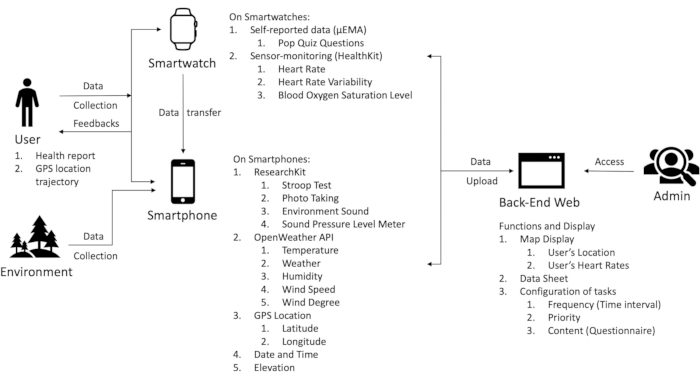
Figure 1: Overview of the app. The functions of the app on the smartwatch, smartphone, and database. Please click here to view a larger version of this figure.
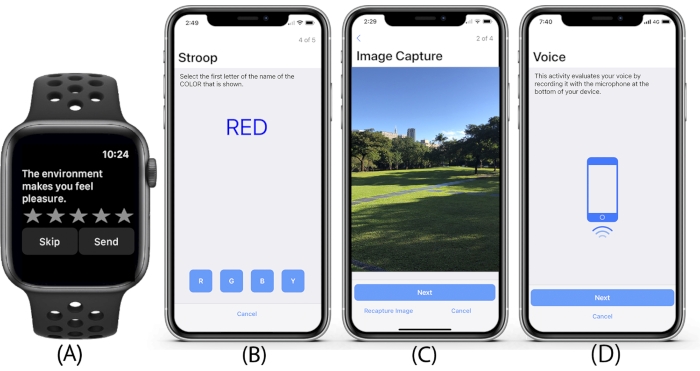
Figure 2: The app tasks. Examples of the tasks that can be used on the app: from left to right, there is (A) The Pop-up question. (B) The Stroop Test. (C) The Image Capture task. (D) The Environment Sound task. Please click here to view a larger version of this figure.
All data will be uploaded to the backend website (access to cooperative researchers, see Table of Materials). The website provides several primary functions: a map display that shows users' current locations and heart rate (Figure 3), a datasheet for browsing and extracting data (Figure 4), and task configurations for modifying the frequency, priority, and content of the tasks (Figure 5). With such great flexibility and a wide range of measurements, researchers can easily select the previously stated task functions according to the research objectives. In addition, the app can benefit both users and researchers. The app provides their health reports and GPS location trajectories (Figure 6) according to the questions they have answered and their chosen routes. Thus, they can obtain a quick idea of their health status on the day and keep on tracking their health data.
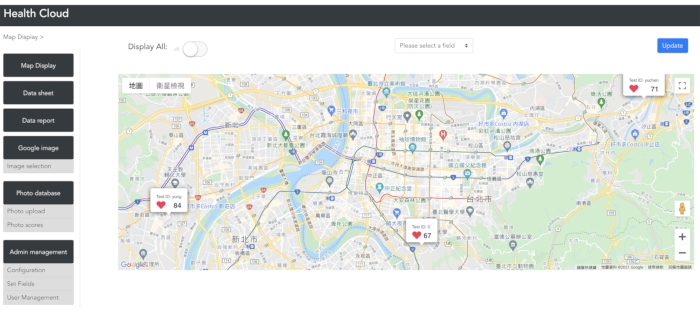
Figure 3: The map displayed on the app database. The map display of the app database provides current information, including locations and heart rate, to the researchers. Please click here to view a larger version of this figure.
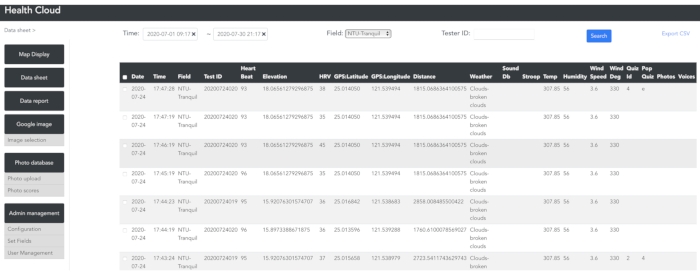
Figure 4: Datasheet on the app database. The data report of the display map in the app database, in which data can be exported by filtering the Time, Field, or Tester ID. Please click here to view a larger version of this figure.
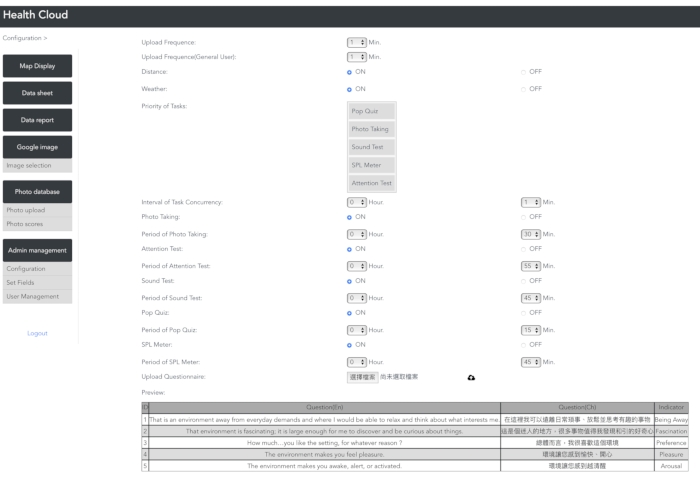
Figure 5: The task configuration on the app database. The task priorities, time intervals, language, and content of the questionnaires can be modified. Please click here to view a larger version of this figure.
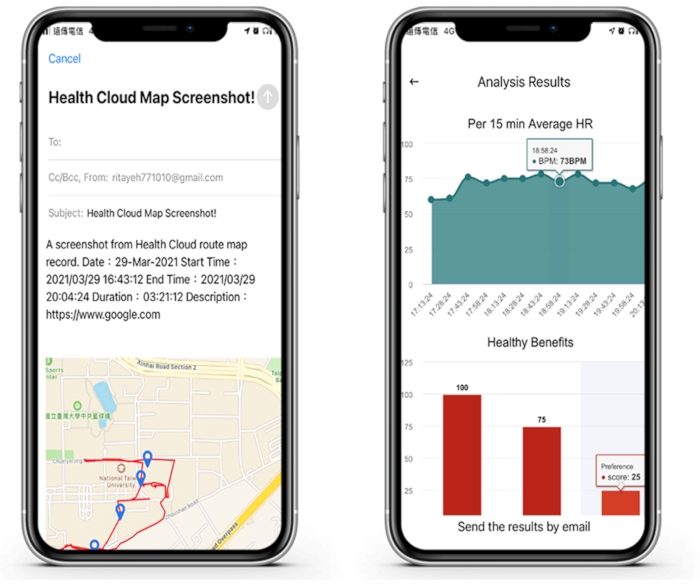
Figure 6: The health report for the app users. After using the app, the user can receive a set of individual results generated automatically. Please click here to view a larger version of this figure.
Representative study
To showcase the integration of diverse dimensions of data collection using the app on smartphones and smartwatches, an in situ study was conducted in 2020 at the National Taiwan University campus in Taipei City, Taiwan. Participants for the study were recruited on the social media fan page of National Taiwan University through an online form 1 week before the experiment. The form included the research purpose, process, location, participation conditions, a schematic diagram of the research device to be worn, and a space for readers to indicate their willingness to participate and the time at which they could do so. After completion, participants were notified of their experiment's exact time and location by email 2 days before the schedule. Since the research examines psychological changes, physiology, physical activity (walking), and sound and color perception, participants met the following conditions: (1) between 20-36 years old, (2) good physical and mental health, (3) not be in regular use of drugs affecting the central nervous system, (4) not be pregnant or breastfeeding, (5) have no history of cardiovascular disease, (6) can walk for more than 30 min on foot, (7) be able to identify a color.
On the day of the experiment, participants were provided with one set of smartphones and smartwatches, and a route map. Researchers presented a uniform explanation to the participants of the purpose of the research, the research process, the wearable devices, and the matters needing attention in the research process. During the walk, psychological responses were assessed using a Pop Quiz task every 5 min, and physiological responses, such as heart rate, were measured every minute by sensors in the smartwatch. After the experiment, participants were compensated with a 200 NTD equivalent gift card (~7 USD).
For the psychological measurement, this study considered landscape preferences and two aspects of the Perceived Restorative Scale Short Version30, namely, "being away" and "fascination." These aspects were measured by asking participants to rate the statements "This is a place which is away from everyday demands and where I would be able to relax and think about what interests me." and "That place is fascinating; it is large enough for me to discover and be curious about things." on a five-point Likert scale from (1) "strongly disagree" to (5) "strongly agree" to measure individual perceptions of the restorative factors of the environment based on attention restoration theory31. Landscape preference was assessed using a five-point Likert scale with the single question: "How much do you like the setting, for whatever reason?" from (1) "very little" to (5) "very much." The questionnaire was sent using the "Pop Quiz" task with a 5 min time interval, meaning participants received the questionnaire every 5 min.
For physiological measurement, heart rate (HR) while walking was used to represent the participants' physiological outcomes with a 1 min time interval. Environmental information, including GPS data (latitude and longitude), temperature, relative humidity, wind speed, and wind degree, were collected through the smartphone.
Protocol
Representative Results
Discussion
Purposes of the study and significant findings
Wearable devices, such as smartphones and smartwatches, have been widely used to investigate physiological indicators or syndromes32,33,34, psychological states22,35; environmental information, or behaviors18,36. Most applications of smart devi…
Divulgations
The authors have nothing to disclose.
Acknowledgements
The Council of Agriculture of Taiwan funded the research project and the HealthCloud app development from 2018 to 2020 [109 agricultural science – 7.5.4-supplementary-#1(1)] ([109  -7.5.4-
-7.5.4- -#1(1)]).
-#1(1)]).
Materials
| Apple Watch 6 | Apple | For the use of the HealthCloud app, such as Pop-up questions, heart rates measurement. | |
| iPhone | Apple | For the use of the HealthCloud app, such as GPS location collection, weather data colledction, data storage, data transfer. | |
| HealthCloud | Self-developed | The HealthCloud app, adopting Apple Watch and iPhone, was developed by Healthy Landscape and Healthy People Lab, National Taiwan University (HLHP-NTU) to track human responses. It adopted several APIs such as HealthKit, ResearchKit, Weather API and AppleWatch applications including Breathe app, and Blood Oxygen app to collect physiological status and psychological states, and environmental data in aims of further analyzing the relationships between human health and the environmental information. The link to the app in APP Store is as following: https://apps.apple.com/tw/app/healthcloud/id1446179518?l=en |
|
| backend website | The backend website of HealthCloud app for the use of the configuration of the tasks, data exportation, and the display of users. http://healthcloud.hort.ntu.edu.tw/ |
||
| HealthKit | Apple | For the use of retrieving the data of physiological responses such as heart rate, heart rate variability, and blood oxygen saturation level. The link to the HealthKit: https://developer.apple.com/documentation/healthkit |
|
| ResearchKit | Apple | This kit includes a variety of tasks for the use of research purposes. The functions adopted in HealthCloud app include Image Capture task, environment sound task, Stroop Test, to the Pop Questions of psychological state measurements such as perceived restorativeness scale, landscape preferences. The link to the ResearchKit: https://www.researchandcare.org/ |
|
| Weather API | OpenWeather | For the use of collecting the real-time environmental data, including humidity, weather, global positioning system location, altitudes, etc., from the nearest weather station. The link to the Weather API: https://openweathermap.org/api |
|
| Breathe app | Apple | For the use of assessing the real-time heart rate variability (HRV). This app was not included in the procedures of this pilot study. However, the HealthlCloud is now capable of retrieving the HRV data collected from Breathe app. The link to the Breathe app: https://apps.apple.com/us/app/breathe/id1459455352 |
|
| Blood Oxygen app | Apple | For the use of assessing the real-time Blood Oxygen Concentration level (SpO2). The latest version of HealthlCloud is capable of retrieving the SpO2 data collected from app. This app was not included in the procedures of this pilot study. However, The measurement of Blood Oxygen app: https://support.apple.com/en-us/HT211027 The link to the Blood Oxygen app: https://apps.apple.com/us/app/breathe/id1459455352" |
|
| IBM SPSS Statistics 25 | IBM | For the use of statistical analysis. The link to the Blood Oxygen app: https://www.ibm.com/support/pages/downloading-ibm-spss-statistics-25 |
References
- Purcell, T., Peron, E., Berto, R. Why do preferences differ between scene types. Environment and Behavior. 33 (1), 93-106 (2001).
- Engell, T., Lorås, H. W., Sigmundsson, H. Window view of nature after brief exercise improves choice reaction time and heart rate restoration. New Ideas in Psychology. 58, 100781 (2020).
- Ding, N., Berry, H. L., Bennett, C. M. The importance of humidity in the relationship between heat and population mental health: Evidence from Australia. PLOS ONE. 11 (10), 0164190 (2016).
- Majeed, H., Lee, J. The impact of climate change on youth depression and mental health. The Lancet Planetary Health. 1 (3), 94-95 (2017).
- Merkies, K., et al. Preliminary results suggest an influence of psychological and physiological stress in humans on horse heart rate and behavior. Journal of Veterinary Behavior. 9 (5), 242-247 (2014).
- Delaney, J. P. A., Brodie, D. A. Effects of short-term psychological stress on the time and frequency domains of heart-rate variability. Perceptual and Motor Skills. 91 (2), 515-524 (2000).
- South, E. C., Kondo, M. C., Cheney, R. A., Branas, C. C. Neighborhood blight, stress, and health: a walking trial of urban greening and ambulatory heart rate. American Journal of Public Health. 105 (5), 909-913 (2015).
- Rimmele, U., et al. Trained men show lower cortisol, heart rate and psychological responses to psychosocial stress compared with untrained men. Psychoneuroendocrinology. 32 (6), 627-635 (2007).
- Jo, H., Song, C., Miyazaki, Y. Physiological benefits of viewing nature: A systematic review of indoor experiments. International Journal of Environmental Research and Public Health. 16 (23), 4739 (2019).
- Bowler, D. E., Buyung-Ali, L. M., Knight, T. M., Pullin, A. S. A systematic review of evidence for the added benefits to health of exposure to natural environments. BMC Public Health. 10 (1), 1-10 (2010).
- Olafsdottir, G., et al. Health benefits of walking in nature: A randomized controlled study under conditions of real-life stress. Environment and Behavior. 52 (3), 248-274 (2020).
- Beute, F., De Kort, Y., IJsselsteijn, W. Restoration in its natural context: How ecological momentary assessment can advance restoration research. International Journal of Environmental Research and Public Health. 13 (4), 420 (2016).
- Shiffman, S., Stone, A. A., Hufford, M. R. Ecological momentary assessment. Annual Review of Clinical Psychology. 4, 1-32 (2008).
- Hektner, J. M., Schmidt, J. A., Csikszentmihalyi, M. . Experience sampling method: Measuring the quality of everyday life. , (2007).
- Robbins, M. L., Kubiak, T., Mostofsky, D. I. Ecological momentary assessment in behavioral medicine: Research and practice. The Handbook of Behavioral Medicine. 1, 429-446 (2014).
- Fave, A. D., Bassi, M., Massimini, F. Quality of experience and risk perception in high-altitude rock climbing. Journal of Applied Sport Psychology. 15, 82-98 (2003).
- Ates, H. C., Yetisen, A. K., Güder, F., Dincer, C. Wearable devices for the detection of COVID-19. Nature Electronics. 4 (1), 13-14 (2021).
- Cagney, K. A., Cornwell, E. Y., Goldman, A. W., Cai, L. Urban mobility and activity space. Annual Review of Sociology. 46, 623-648 (2020).
- Chaix, B. Mobile sensing in environmental health and neighborhood research. Annual Review of Public Health. 39, 367-384 (2018).
- York Cornwell, E., Goldman, A. W. Neighborhood disorder and distress in real time: Evidence from a smartphone-based study of older adults. Journal of Health and Social Behavior. 61 (4), 523-541 (2020).
- Ashbrook, D. L., Clawson, J. R., Lyons, K., Starner, T. E., Patel, N. Quickdraw: The impact of mobility and on-body placement on device access time. Proceedings of the SIGCHI Conference on Human Factors in Computing Systems (CHI ’08). , 219-222 (2008).
- Hänsel, K., Alomainy, A., Haddadi, H. Large scale mood and stress self-assessments on a smartwatch. Proceedings of the 2016 ACM International Joint Conference on Pervasive and Ubiquitous Computing: Adjunct. , 1180-1184 (2016).
- Karmen, C. L., Reisfeld, M. A., McIntyre, M. K., Timmermans, R., Frishman, W. The clinical value of heart rate monitoring using an apple watch. Cardiology in Review. 27 (2), 60-62 (2019).
- Hernando, D., Roca, S., Sancho, J., Alesanco, &. #. 1. 9. 3. ;., Bailón, R. Validation of the apple watch for heart rate variability measurements during relax and mental stress in healthy subjects. Sensors. 18 (8), 2619 (2018).
- Shcherbina, A., et al. Accuracy in wrist-worn, sensor-based measurements of heart rate and energy expenditure in a diverse cohort. Journal of Personalized Medicine. 7 (2), 3 (2017).
- Samol, A., et al. Patient directed recording of a bipolar three-lead electrocardiogram using a smartwatch with ECG function. Journal of Visualized Experiments. (154), e60715 (2019).
- Verdecchia, P., Angeli, F., Gattobigio, R. Clinical usefulness of ambulatory blood pressure monitoring. Journal of the American Society of Nephrology. 15, 30-33 (2004).
- Ponnada, A., Haynes, C., Maniar, D., Manjourides, J., Intille, S. Microinteraction ecological momentary assessment response rates: Effect of microinteractions or the smartwatch. Proceedings of the ACM on interactive, mobile, wearable and ubiquitous technologies. 1 (3), 1-16 (2017).
- . Monitor your heart rate with Apple Watch Available from: https://support.apple.com/en-us/HT204666 (2021)
- Berto, R. Exposure to restorative environments helps restore attentional capacity. Journal of Environmental Psychology. 25 (3), 249-259 (2005).
- Kaplan, S. The restorative benefits of nature: Toward an integrative framework. Journal of Environmental Psychology. 15 (3), 169-182 (1995).
- Firth, J., et al. Can smartphone mental health interventions reduce symptoms of anxiety? A meta-analysis of randomized controlled trials. Journal of Affective Disorders. 218, 15-22 (2017).
- Turakhia, M. P., et al. Rationale and design of a large-scale, app-based study to identify cardiac arrhythmias using a smartwatch: The Apple Heart Study. American Heart Journal. 207, 66-75 (2019).
- Weenk, M., et al. Continuous monitoring of vital signs using wearable devices on the general ward: Pilot study. JMIR mHealth and uHealth. 5 (7), 91 (2017).
- Wang, R., et al. StudentLife: Assessing mental health, academic performance and behavioral trends of college students using smartphones. Proceedings of the 2014 ACM international joint conference on pervasive and ubiquitous computing. , 3-14 (2014).
- Vhaduri, S., Munch, A., Poellabauer, C. Assessing health trends of college students using smartphones. 2016 IEEE Healthcare Innovation Point-Of-Care Technologies Conference IEEE. HI-POCT. , 70-73 (2016).
- Ståhl, A., Höök, K., Svensson, M., Taylor, A. S., Combetto, M. Experiencing the affective diary. Personal and Ubiquitous Computing. 13 (5), 365-378 (2009).
- Khushhal, A., et al. Validity and reliability of the Apple Watch for measuring heart rate during exercise. Sports Medicine International Open. 1 (6), 206-211 (2017).
- Walsh, E. I., Brinker, J. K. Should participants be given a mobile phone, or use their own? Effects of novelty vs utility. Telematics and Informatics. 33 (1), 25-33 (2016).
- Enock, P. M., Hofmann, S. G., McNally, R. J. Attention bias modification training via smartphone to reduce social anxiety: A randomized, controlled multi-session experiment. Cognitive Therapy and Research. 38 (2), 200-216 (2014).
- Reid, S. C., et al. A mobile phone application for the assessment and management of youth mental health problems in primary care: A randomised controlled trial. BMC Family Practice. 12, 131 (2011).
- Huang, S., Qi, J., Li, W., Dong, J., vanden Bosch, C. K. The contribution to stress recovery and attention restoration potential of exposure to urban green spaces in low-density residential areas. International Journal of Environmental Research and Public Health. 18 (16), 8713 (2021).
- Doherty, S. T., Lemieux, C. J., Canally, C. Tracking human activity and wellbeing in natural environments using wearable sensors and experience sampling. Social Science & Medicine. 106, 83-92 (2014).
- Birenboim, A., Dijst, M., Scheepers, F. E., Poelman, M. P., Helbich, M. Wearables and location tracking technologies for mental-state sensing in outdoor environments. The Professional Geographer. 71 (3), 449-461 (2019).
- Kheirkhahan, M., et al. A smartwatch-based framework for real-time and online assessment and mobility monitoring. Journal of Biomedical Informatics. 89, 29-40 (2019).

